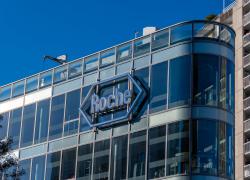
GSK’s Blenrep Dreamm remains alive
Some light is shed on Dreamm-7, but precisely why this trial was successful remains a mystery.
Some light is shed on Dreamm-7, but precisely why this trial was successful remains a mystery.

GSK has reiterated its plan to take to the regulators the Dreamm-7 study of its anti-BCMA antibody-drug conjugate Blenrep in second-line multiple myeloma, and last night’s ASCO plenary series heard continued enthusiasm: the trial’s presenter, Dr Maria-Victoria Mateos, said Blenrep was now a potentially new standard of care for “second-line or later” multiple myeloma.
That’s quite the turnaround, given that Blenrep’s initial approval, in a late-line setting, had to be withdrawn after the Dreamm-3 trial showed no survival benefit versus Pomalyst plus dexamethasone. Accordingly doctors have important questions about the robustness of the Dreamm-7 result, and the ASCO session did answer at least some of these.
Most importantly, the Dreamm-7 topline data seem robust. The study compared Blenrep plus Velcade and dexamethasone versus Darzalex/Velcade/dex, and GSK earlier trumpeted a beat on PFS plus a strong and clinically meaningful OS trend; Mateos, of Hospital Universitario de Salamanca, unveiled Kaplan-Meier curves showing sustained separation on both measures.
Specifically, median PFS was 36.6 months versus 13.4 months, yielding a 0.41 hazard ratio (p<0.0001). Risk of death, meanwhile, was cut by 43%, which was described as impressive despite the relatively small number of deaths (12% of the Dreamm-7 population) seen at this interim analysis.
Blenrep is known to carry eye toxicity, and grade 3 or higher events of this nature were experienced by 34% of Dreamm-7’s active cohort patients. Severe thrombocytopenia was also called out – 55% versus 35% for control – and a 26% rate of study discontinuation caused by Blenrep-related adverse events was said to be high, though overall toxicity was in line with expectations.
Darzalex/Velcade/dex carries a second-line multiple myeloma label, on the basis of the Castor study showing mPFS of 16.7 months; this is slightly higher than the 13.4 months in Dreamm-7’s control arm (as is a landmark 12-month OS rate of around 85% in Castor versus 81% in Dreamm-7), but it isn’t sufficiently different to raise immediate questions about the robustness of the Dreamm-7 result.
Why?
If Dreamm-7 is robust then why did it succeed when the later-line Dreamm-3 trial clearly didn’t? This remains unclear, though it appears that if an anti-BCMA ADC like Blenrep is given early enough the chances of success are higher.
But how early should Blenrep be given? The ASCO discussant, Dr Rachid Baz from Lee Moffitt Cancer Center, homed in on a key issue, namely that just half the Dreamm-7 patients had received Revlimid, and only a third were refractory to it.
Dreamm-7 is a second-line trial, and Revlimid is a front-line standard; it was “uncommon to see so many patients who were not Revlimid refractory”, Baz said.
On this score he drew a distinction between Dreamm-7 and the second-line Cartitude-4 trial of J&J's Carvykti, where all patients were Revlimid-refractory. Carvykti, like Bristol Myers Squibb’s Abecma, is an anti-BCMA Car-T therapy, and both are facing a US advisory committee meeting on 15 March to discuss issues in studies that seek to back their second-line approvals.
Another problem with Dreamm-7 is that nothing has been revealed about what subsequent therapies patients had received. Treatment sequencing is a contentious area in multiple myeloma, but it’s especially important to see data on subsequent BCMA-directed therapy in Dreamm-7, Baz said.
He cited academic studies showing that Carvykti yielded lower PFS in Blenrep-exposed versus Blenrep-naive patients; but he called ORRs of around 55% seen with the T-cell engagers Tecvayli and elranatamab when given after Blenrep “still quite good” if a little low.
One irony of Dreamm-7 is that it was intended to serve as a trial to expand Blenrep’s approved use from relapsed-refractory to second-line multiple myeloma, additionally showing a benefit in non Revlimid-refractory patients; but Baz said only that it supported Blenrep in relapsed/refractory multiple myeloma.
That’s the precise use Blenrep lost owing to Dreamm-3. Regulators must now decide: reinstate the Dreamm-3 setting, approve Blenrep second line, or continue to keep the drug off the market.
Dreamm-7 summary
| Blenrep + Velcade + dex | Darzalex + Velcade + dex | |
|---|---|---|
| mPFS^ | 36.6mth | 13.4mth |
| HR=0.41 (p<0.0001) | ||
| PFS in Revlimid exposed | HR=0.33 | |
| PFS in Revlimid non-exposed | HR=0.57 | |
| PFS in Revlimid refractory | HR=0.37 | |
| PFS in Revlimid non-refractory | HR=0.48 | |
| 12mth OS | 87% | 81% |
| HR=0.57 (p=0.00049*) | ||
| ORR | 83% (35% CR rate) | 71% (17% CR rate) |
| Subsequent therapy | Not disclosed | Not disclosed |
Notes: ^sole primary endpoint; *one-sided p value, did not clear 0.00037 interim bar for statistical significance. Source: ASCO Feb 2024 plenary series.
2157













